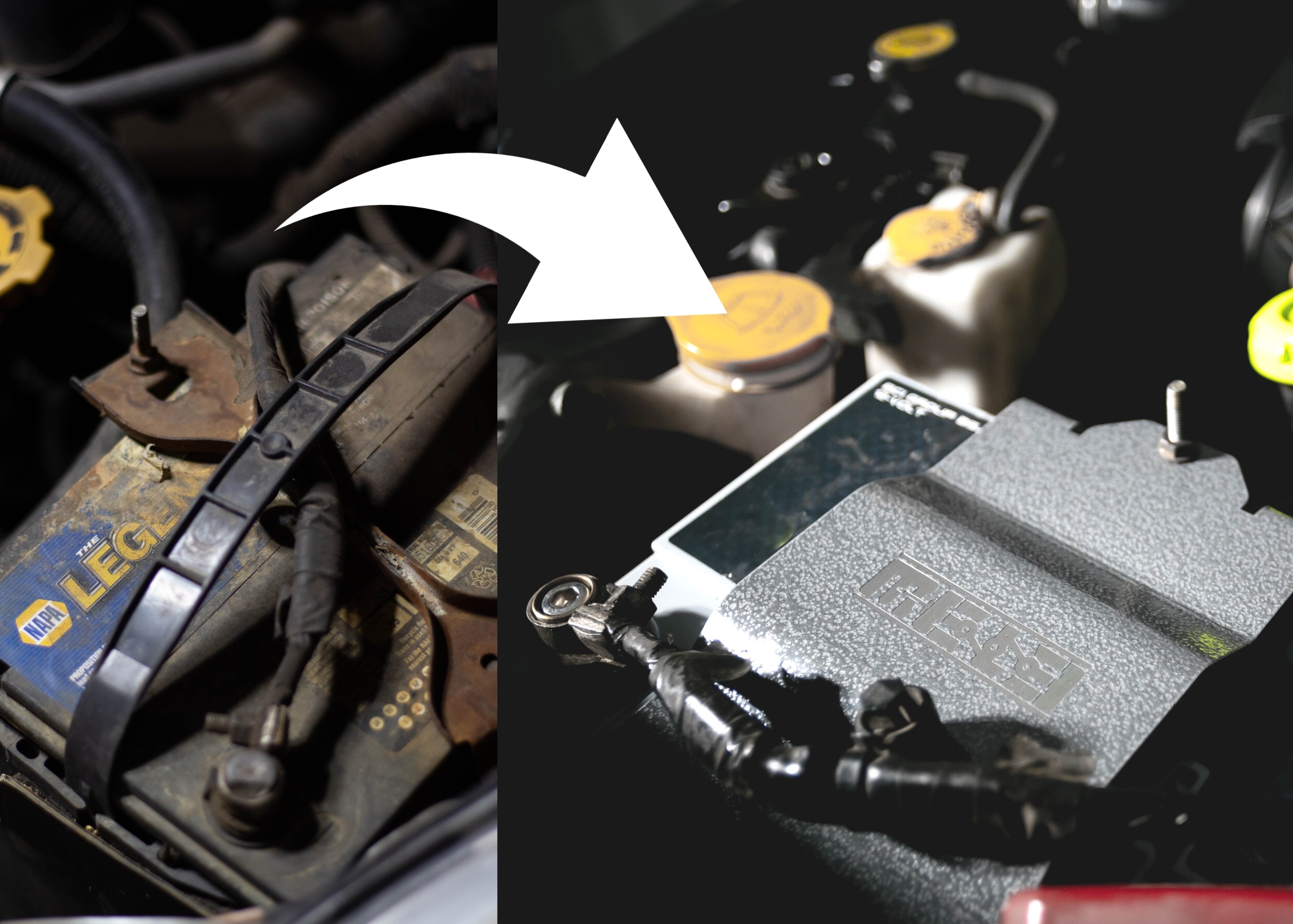
Upgrading a 2011 Subaru Outback's Battery Setup: Reliable AGM Power and a Proper Tie Down
By Ben Boxer
As a long-time Subaru owner with an interest in spending a little more on quality parts (you know the saying “buy once, cry once”) I decided to improve my daily driver 2011 Outback’s performance and reliability by upgrading the battery. I have grown to despise corroded batteries and having to get a jump on cold mornings. In this article, I’ll share my experience switching from a standard lead-acid battery to a more reliable AGM (Absorbent Glass Mat) battery and bringing it all together with an upgraded tie down.
I’ll cover the reasons why I decided to upgrade, what some of the benefits are, and then show how much better it looks with the new battery and upgraded tie down. Let’s jump in and get started!
Table of Contents
Why I Made the Switch to AGM Batteries:
In this specific car I was experiencing some hard start issues when the vehicle had sat for more than a day. The battery was old and constantly corroding. If I cleaned it, I’d come back two weeks later to find it just as corroded. I finally decided it was time to replace it. But I initially started researching better battery solutions years ago after I had a battery failure out in the forest, miles away from any pavement. I was luckily able to find someone to help me jump the car within a short hiking distance. But that could have been a dangerous situation for me.
Once I started digging around, I discovered that AGM batteries are engineered to resist the exact type of driving I do in the lifted Subie. It also doesn’t take a bunch of crazy modification to install one of these batteries since they are available in many of the exact same sizes as wet-cell batteries. You can easily purchase the correct size and drop it right in to your Subaru’s original battery compartment and gain a bunch of added benefits. Not only are AGM batteries easy to install, but they offer a few specific features when compared to cheaper lead-acid options:
1. Better Performance and Premium Materials
AGM batteries have lower internal resistance, enabling them to deliver a greater current to the starter motor. This feature becomes particularly crucial during cold weather when the starter motor has exert additional effort to crank the engine. I live in an area with really cold winter conditions from November to February. So switching to AGM was a no brainer for me. AGM batteries also have a higher discharge rate, translating to an increased power supply to the vehicle’s electrical system when it operates under load.
On the topic of starters, having a better battery that can rotate the starter more effectively actually increases its lifespan. Since the starter isn’t having to crank the motor as long, there’s less heat generation which means less wear and tear on the starter. This is super important to me for the amount of time I spend out in the wilderness.
I also really like the fact that the Full Throttle AGM batteries are made using virgin lead and are produced in-house at facilities that they have direct control over. This means that quality control numbers are going to be much higher and each individual battery will operate the way it was meant to right out of the box.
2. Extended Battery Lifespan
Unlike lead-acid batteries, AGM batteries are less susceptible to sulfation, a phenomenon where lead sulfate accumulates on the battery plates, reducing its capacity and shortening its life expectancy. When you see corrosion build up on your battery posts, this is a result of sulfation and it is one of the biggest killers of a battery. AGM units avoid this issue. Also, AGM batteries are far more resistant to vibration and shock, which promotes an extended lifespan for people like myself who like to drive off-road.
Additionally, AGM batteries are less prone to leakage compared to lead-acid batteries. This means that you’re less likely to experience frame rail damage from rust due to battery acid contamination. I have experienced this in the past and it’s devastating to realize that a cheap battery caused permanent rust damage to my vehicle.
The fact that these batteries seem to have a longer lifespan also pencils out financially in the long run. Replacing the battery that was already in the car with the exact same lead-acid unit would have cost $205. The Full Throttle battery was roughly $150 more. However, there are people that have been running these AGM batteries for 8-10 years. This is double what I expect any cheaper battery to last and is less than double the cost for a battery that performs better for twice as long.
3. Peace of Mind
The peace of mind that I have from putting a high-quality battery under my Subie’s hood is worth every penny. It gives me a sense of security, particularly when navigating remote areas or during extreme weather conditions during the winter. I do NOT play games when it comes to simple things I can do to add reliability to my cars. I don’t have time to be stranded or wait for tow trucks. After spending years working in the commercial auto parts industry, I simply don’t trust cheaply made batteries anymore.
Of course, AGM batteries are generally more expensive than lead-acid batteries, but the long-term benefits in terms of enhanced performance and durability make the investment worthwhile for me. I have upgraded every single one of my cars to AGM batteries and couldn’t be happier. I’ve never had a single problem starting any of the cars or using any of my off-road accessories.
Here’s the Full Throttle FT750-35 battery and MeLe tie down that I decided to install in my Outback:
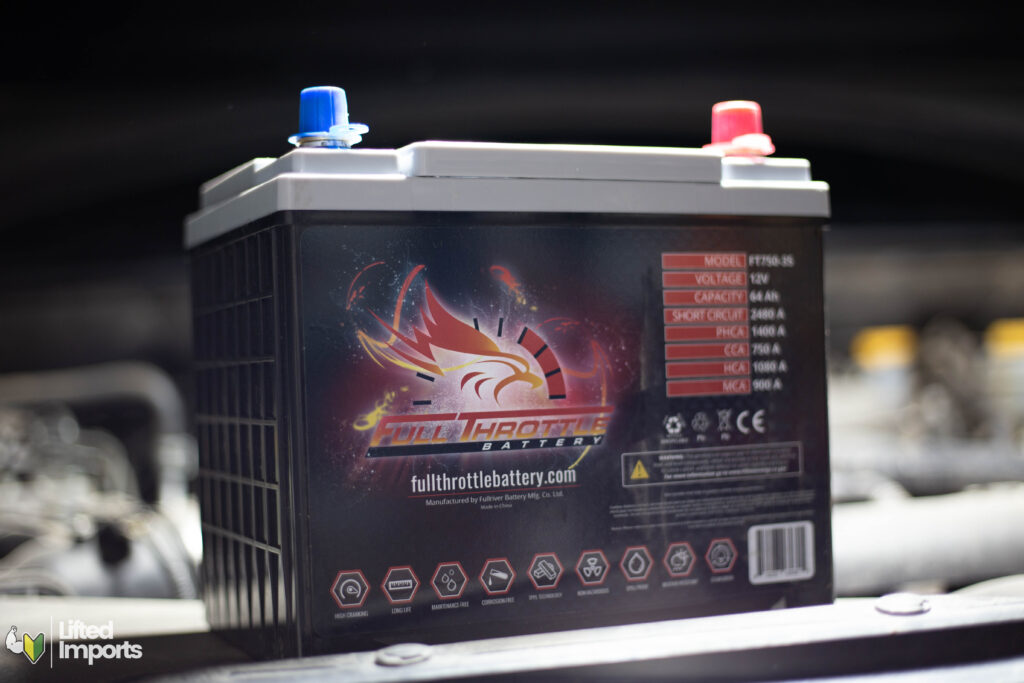
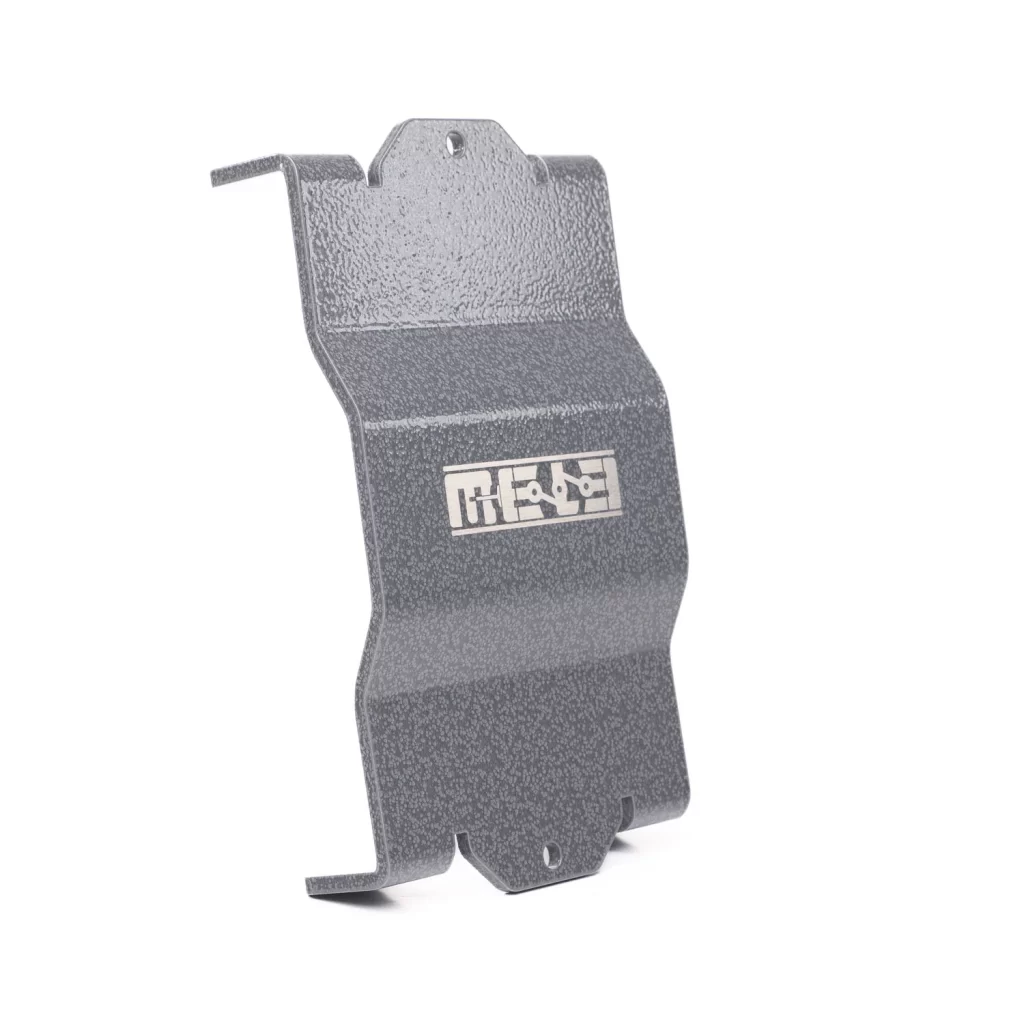
Okay let’s jump in to the battery installation process that I used. This is what I did, but I always recommend consulting with a professional mechanic when working on a vehicle.
Installation – Here’s What I Did:
Prepping for the Job:
Safety: One of the first things I do before working on my cars is grab a pair of rubber gloves. You’re going to be working with items that could be contaminated with battery acid.
Gather the Right Tools and Parts:
I used a battery terminal cleaner, a 10mm deep socket, and a basic ratchet to perform the entire install.
- The parts I used: Full Throttle FT750-35 AGM battery, MeLe Design Firm Group 35 battery tie down
Removing the Old Battery:
Locate the Battery: In Subarus, the battery is almost always going to be on the driver’s side in the front of the engine bay.
Disconnect Cables: I began by disconnecting the negative battery terminal using my 10mm socket. I always move it out of the way so that there’s no risk of it touching anything that it shouldn’t. Then I move to the positive terminal and move it out of the way as well. When I’m performing this step, I take extra care not to touch my tools to the battery posts.
Remove the Old Battery & Clean Terminals: Once the battery terminals are taken off and safely moved to the side, I used a deep 10mm socket to undo the battery tie down bracket. Then I gently pulled the old battery out of the engine bay and set it safely on the floor out of the way. At this point I used my terminal cleaner to remove any corrosion on the terminals and I used a shop vac to clean out the entire battery area in the engine bay. I also found some rust damage below the battery from acid leakage. So I sanded down the rust and painted over it to preserve the metal. Hopefully this isn’t something you have to worry about.
Installing the New Battery:
Drop the New Battery in: Next, I put the new battery into the tray taking special care to ensure that the terminals are oriented the same way as the factory battery. I always like to make sure there’s nothing accidentally getting pinched as I lower the battery down into the tray. Sometimes the cables can fall down as you’re lowering it.
Install the New MeLe Tie Down: I placed the new tie down over the top of the new Full Throttle battery and centered it correctly. Then I put the j hooks down in their slot one at a time using one hand to hold it and the other hand to thread the nut on. Once both are in place, I snug them both down.
Reconnect Cables: At this point I re-install the positive and then negative cable taking extra care to put them on the correct battery post. Be sure not to reverse the cables. Doing this can severely damage the vehicle.
Safety Checks: I always double check my work and ensure that both terminals are tightened properly.
Post-Installation Finishing Touches:
Fully Charge the System: I use my NoCo charger to top off the new battery and make sure it’s good to go. I do this any time I install a new battery or if the car has been sitting for awhile. I haven’t had a Full Throttle battery lose any charge during shipping, but I check every time regardless.
Idle Re-Learn Process: Many Subarus need to go through a procedure to reset the idle when the battery has been disconnected for a long period of time. This process may vary based on the year and model of your Subaru. But it will drastically improve your car’s performance by taking a few minutes to let it relearn. Here’s the exact video I used to perform the idle relearn process the first time I heard about it:
11. Proper Disposal: Any time I install a new battery, I take the old one to either Oreilly’s or Autozone to have them recycled. Both of those stores currently offer a gift card when you take them an old battery to be recycled. Never dispose of the battery in the trash. They contain toxic chemicals that need to be handled properly.
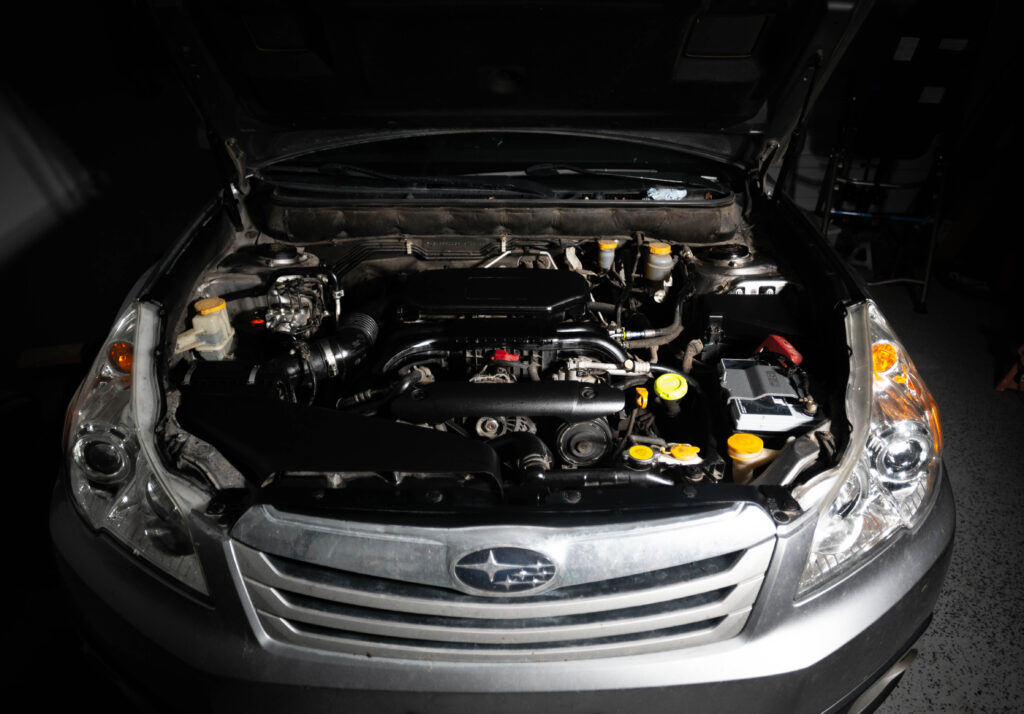
Premium Battery Tie Down – Why Upgrade?
It’s important to make sure that your battery is absolutely secured without being able to move around. A loose battery can damage your vehicle’s electrical system and even start fires in the event of an accident. This means that your tie down needs to be snugged down against your battery correctly with enough force to hold it tight. The OEM Subaru tie downs are thin, easily rust, and apply concentrated pressure to one small section of the battery. When there’s pressure against a small area on the battery, it can deform the case and lead to premature failure. I wanted to not only dress up the engine bay a little bit but also spread out the force being applied to the top of the battery for a safe, secure fit. I’ve been using MeLe Design Firm products for awhile and their new group 35 tie down was exactly what I needed for this project. So I grabbed one of the hammertone finish models and installed it along with the new battery.
Since these tie downs are 5052 US-sourced aluminum, I won’t have to worry about rust and the wide design will evenly distribute pressure across the battery to hold it in place. I’ve become somewhat of a “parts nerd” that enjoys accessories that display good attention to detail and made using local materials. This mount met those needs and really rounded off this install perfectly. Check out how good it looks compared to the old rusted out mount:

Here’s the old battery setup. Please note that at one point, a previous battery had corroded so bad that it actually caused rust damage to the battery platform on the frame. I had to sand it down and put some paint over it to stop the rust from spreading. Fortunately, I caught it before it spread. You can see some of that rust on the old tie down. It was completely covered in it and had to be thrown away.
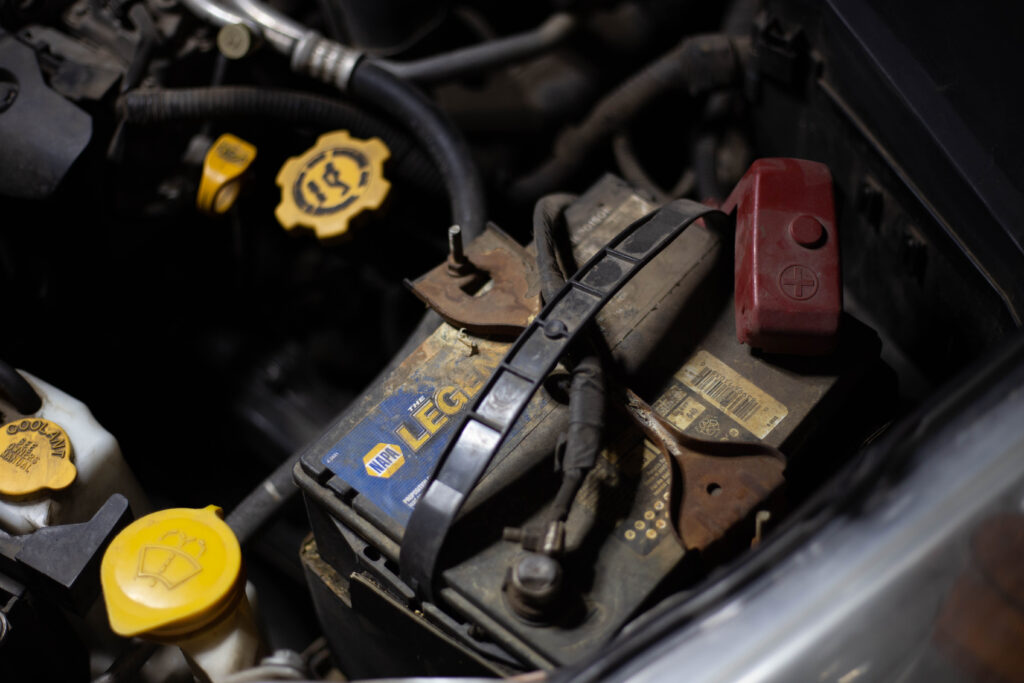
Overall, I feel really good about this installation. I haven’t had anymore hard start issues and I know there won’t be anymore corrosion problems with the new battery. These Full Throttle AGM units have been super reliable and have made cold mornings a breeze compared to the old lead-acid batteries I used to have in my cars. AGM batteries are reliable, and the tie-down upgrade looks really. Consider making the switch to a better battery – it’s an investment in your Subaru’s performance and reliability, and it’s one I’ve never regretted.
What kind of batteries are you considering for an upgrade? Share your car's year/make/model and the different batteries you've been looking at.

4 thoughts on “Subaru Outback AGM Battery Upgrade: Engine Bay Makeover”
I’ve been also wanting to upgrade to an AGM battery now that I have a winch! I’ve got a 2021 Crosstrek and the OEM battery seems to constantly corrode exactly like what you mentioned. That battery strap looks really good too!
Larry, I really enjoy these Full Throttle batteries. I’m running them on all my cars now! But there’s a lot of really good options out there. Let me know what you go with:D What kind of winch do you have on the Crosstrek?
Thanks for thr great article!
My pleasure! Just want to help:)